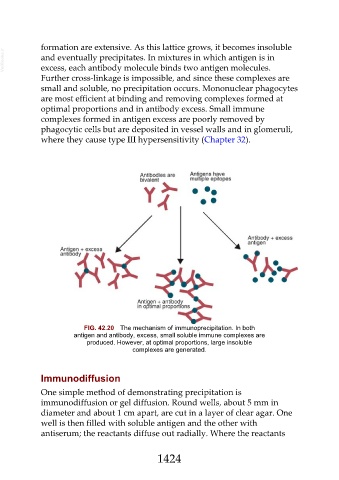Page 1424 - Veterinary Immunology, 10th Edition
P. 1424
formation are extensive. As this lattice grows, it becomes insoluble
VetBooks.ir and eventually precipitates. In mixtures in which antigen is in
excess, each antibody molecule binds two antigen molecules.
Further cross-linkage is impossible, and since these complexes are
small and soluble, no precipitation occurs. Mononuclear phagocytes
are most efficient at binding and removing complexes formed at
optimal proportions and in antibody excess. Small immune
complexes formed in antigen excess are poorly removed by
phagocytic cells but are deposited in vessel walls and in glomeruli,
where they cause type III hypersensitivity (Chapter 32).
FIG. 42.20 The mechanism of immunoprecipitation. In both
antigen and antibody, excess, small soluble immune complexes are
produced. However, at optimal proportions, large insoluble
complexes are generated.
Immunodiffusion
One simple method of demonstrating precipitation is
immunodiffusion or gel diffusion. Round wells, about 5 mm in
diameter and about 1 cm apart, are cut in a layer of clear agar. One
well is then filled with soluble antigen and the other with
antiserum; the reactants diffuse out radially. Where the reactants
1424

